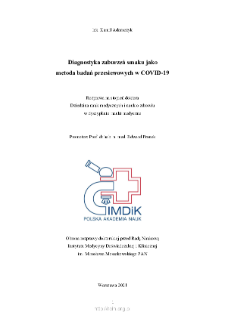- Search in all Repository
- Literature and maps
- Archeology
- Mills database
- Natural sciences
Advanced search
Advanced search
Advanced search
Advanced search
Advanced search

Object
Title: Dignostyka zaburzeń smaku jako metoda badań przesiewowych w COVID-19
Contributor:
Publisher:
Instytut Medycyny Doświadczalnej i Klinicznej im. M. Mossakowskiego PAN
Place of publishing:
Description:
Bibliografia zawiera 346 pozycje ; 123 s.: tabl.; 30 cm.
Degree name:
Level of degree:
Degree discipline :
Degree grantor:
Instytut Medycyny Doświadczalnej i Klinicznej im. M. Mossakowskiego PAN
Abstract:
The aim of the work was:1. Assessment of the characteristics of taste disturbances in the course of COVID-19, taking into account the disturbances of particular tastes.2. Development of a predictive model of SARS-CoV-2 virus infection based on the objectivetaste test.3. Comparison of the effectiveness of predictive models based on subjective COVID-19symptoms with models based on the objective taste test. Conclusion:I. Infection with SARS-CoV-2 virus affects the perception of tastes, selectively impairing theperception of sweet and salty taste. These disturbances consist of hypogeusia corresponding tothe concentration of the flavor substance. Ageusia in the COVID-19 group is very rare.II. The single taste tester with the highest diagnostic value (the highest ROC-AUC value) forSARS-CoV-2 virus infection, among taste testers and, at the same time, the highest sensitivityamong taste testers, was the sweet taste tester with a sucrose concentration of 40 mg / ml.III. The predictive model based on objective taste tests, with the highest sensitivity, was themodel consisting of the medical questionnaire on subjective symptoms of COVID-19 and theSweet 1 tester test (sucrose concentration 40 mg / ml) – the screening model.IV. The predictive model based on objective taste tests, with the highest specificity, was themodel consisting of the following testers: Salty 1 (sodium chloride concentration 13.5 mg/ml),2Salty 2 (sodium chloride concentration 17 mg / ml), Sweet 3 (sodium chloride concentrationsucrose 106.4 mg / ml) - the diagnostic model.V. The diagnostic value (ROC-AUC value) of the predictive model based on subjectiveCOVID-19 symptoms (medical questionnaire) was higher than the predictive models based onthe objective taste tests. In epidemiological situations requiring the screening tests to beobjective, it may be advisable to use taste tests independently or in conjunction with a medical questionnaire.
Detailed Resource Type:
Resource Identifier:
Source:
IMDiK PAN, sygn. ZS410 ; click here to follow the link
Language:
Language of abstract:
Rights:
Creative Commons Attribution BY 4.0 license
Terms of use:
Copyright-protected material. [CC BY 4.0] May be used within the scope specified in Creative Commons Attribution BY 4.0 license, full text available at: ; -
Digitizing institution:
Mossakowski Medical Research Institute PAS
Original in:
Library of the Mossakowski Medical Research Institute PAS
Projects co-financed by:
Access:
Object collections:
- Digital Repository of Scientific Institutes > Partners' collections > Mossakowski Medical Research Institute PAS > Theses
- Digital Repository of Scientific Institutes > Partners' collections > Mossakowski Medical Research Institute PAS > Theses > Ph.D Dissertationes
Last modified:
May 15, 2024
In our library since:
May 12, 2022
Number of object content downloads / hits:
152
All available object's versions:
https://rcin.org.pl./publication/272086
Show description in RDF format:
Show description in RDFa format:
Show description in OAI-PMH format:
| Edition name | Date |
|---|---|
| Adamczyk, Kamil, 2022, Diagnostyka zaburzeń smaku jako metoda badań przesiewowych w COVID-19 | May 15, 2024 |
Objects Similar
Parysek, Jerzy J. Mierzejewska, Lidia
Śleszyński, Przemysław
Sadłoń, Wojciech
Muazir, Syaiful Lestari Alhamdani, Muhammad Ridha Nurhamsyah, Muhammad
Kawczyńska-Butrym, Zofia Pantyley, Viktoriya Butrym, Marek Kisla, Ganna Fakeyeva, Liudmila
Ziółkowska-Weiss, Kamila Mróz, Franciszek

 INSTYTUT ARCHEOLOGII I ETNOLOGII POLSKIEJ AKADEMII NAUK
INSTYTUT ARCHEOLOGII I ETNOLOGII POLSKIEJ AKADEMII NAUK
 INSTYTUT BADAŃ LITERACKICH POLSKIEJ AKADEMII NAUK
INSTYTUT BADAŃ LITERACKICH POLSKIEJ AKADEMII NAUK
 INSTYTUT BADAWCZY LEŚNICTWA
INSTYTUT BADAWCZY LEŚNICTWA
 INSTYTUT BIOLOGII DOŚWIADCZALNEJ IM. MARCELEGO NENCKIEGO POLSKIEJ AKADEMII NAUK
INSTYTUT BIOLOGII DOŚWIADCZALNEJ IM. MARCELEGO NENCKIEGO POLSKIEJ AKADEMII NAUK
 INSTYTUT BIOLOGII SSAKÓW POLSKIEJ AKADEMII NAUK
INSTYTUT BIOLOGII SSAKÓW POLSKIEJ AKADEMII NAUK
 INSTYTUT CHEMII FIZYCZNEJ PAN
INSTYTUT CHEMII FIZYCZNEJ PAN
 INSTYTUT CHEMII ORGANICZNEJ PAN
INSTYTUT CHEMII ORGANICZNEJ PAN
 INSTYTUT FILOZOFII I SOCJOLOGII PAN
INSTYTUT FILOZOFII I SOCJOLOGII PAN
 INSTYTUT GEOGRAFII I PRZESTRZENNEGO ZAGOSPODAROWANIA PAN
INSTYTUT GEOGRAFII I PRZESTRZENNEGO ZAGOSPODAROWANIA PAN
 INSTYTUT HISTORII im. TADEUSZA MANTEUFFLA POLSKIEJ AKADEMII NAUK
INSTYTUT HISTORII im. TADEUSZA MANTEUFFLA POLSKIEJ AKADEMII NAUK
 INSTYTUT JĘZYKA POLSKIEGO POLSKIEJ AKADEMII NAUK
INSTYTUT JĘZYKA POLSKIEGO POLSKIEJ AKADEMII NAUK
 INSTYTUT MATEMATYCZNY PAN
INSTYTUT MATEMATYCZNY PAN
 INSTYTUT MEDYCYNY DOŚWIADCZALNEJ I KLINICZNEJ IM.MIROSŁAWA MOSSAKOWSKIEGO POLSKIEJ AKADEMII NAUK
INSTYTUT MEDYCYNY DOŚWIADCZALNEJ I KLINICZNEJ IM.MIROSŁAWA MOSSAKOWSKIEGO POLSKIEJ AKADEMII NAUK
 INSTYTUT PODSTAWOWYCH PROBLEMÓW TECHNIKI PAN
INSTYTUT PODSTAWOWYCH PROBLEMÓW TECHNIKI PAN
 INSTYTUT SLAWISTYKI PAN
INSTYTUT SLAWISTYKI PAN
 SIEĆ BADAWCZA ŁUKASIEWICZ - INSTYTUT TECHNOLOGII MATERIAŁÓW ELEKTRONICZNYCH
SIEĆ BADAWCZA ŁUKASIEWICZ - INSTYTUT TECHNOLOGII MATERIAŁÓW ELEKTRONICZNYCH
 MUZEUM I INSTYTUT ZOOLOGII POLSKIEJ AKADEMII NAUK
MUZEUM I INSTYTUT ZOOLOGII POLSKIEJ AKADEMII NAUK
 INSTYTUT BADAŃ SYSTEMOWYCH PAN
INSTYTUT BADAŃ SYSTEMOWYCH PAN
 INSTYTUT BOTANIKI IM. WŁADYSŁAWA SZAFERA POLSKIEJ AKADEMII NAUK
INSTYTUT BOTANIKI IM. WŁADYSŁAWA SZAFERA POLSKIEJ AKADEMII NAUK




































